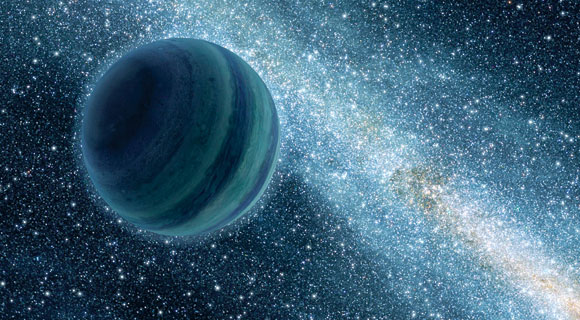
Beyond the Quads
The Loneliest Planet
Eric Switzer, AB’03, and Dorian Abbot say life could thrive in a sunless world.
By Benjamin Recchie, AB’03
Imagine an orphan planet, wandering through the interstellar void far from its home solar system, yet still able to support life. Not long ago such a concept was the exclusive province of science fiction. (It even showed up on an episode of Star Trek.) But a new paper by Dorian Abbot, assistant professor of geophysical sciences, and Eric Switzer, AB’03, a postdoctoral scholar at the University’s Kavli Institute for Cosmological Physics, suggests that maybe it’s time to reclassify this bit of science fiction as science fact.
Astronomers have long theorized that a planet could be ejected from its home solar system after its orbit was altered by the gravity of a nearby larger planet or another star. These “rogue planets” would then travel through space alone; the vast distances between stars virtually ensure the planets would never enter the orbit of another sun. Without a sun to keep it warm, scientists assumed that any such planet would be incapable of supporting life.
A mutual interest in another planet—Earth—originally brought Abbot (by profession a geophysicist) and Switzer (a cosmologist) together. The two had met at a party and discovered they were next-door neighbors. Talking shop, they mused about whether there was a way to reconstruct the climate of prehistoric Earth using statistical methods developed to study the cosmic microwave background.
Switzer had started to work on the problem in earnest when environmentalist Amory Lovins of the Rocky Mountain Institute visited the University. Lovins asked him whether Earth would cool to the temperature of the microwave background—2.73 kelvin—if the sun went out. Switzer determined, to his own surprise, that it wouldn’t; the heat radiating from our planet’s core would actually keep the surface about 35 kelvin (or -238° C).
Switzer realized that if the surface of a sunless Earth was an insulating layer of ice, the heat from the core might provide enough warmth at the bottom of the ice layer to allow water to remain liquid. For fun, he and Abbot tried to figure out how much ice would be needed. The answer was 10 to 15 kilometers of ice—rather a lot, Switzer said, but “not so crazy” considering that the water in Antarctica’s Lake Vostok lies beneath roughly four kilometers of ice. If such a planet existed, and water remained liquid on its ocean floor, then it could conceivably harbor life. The two scientists dubbed their rogue planet with a subglacial ocean as a “Steppenwolf planet,” since, as they put it in their paper, “any life in this strange habitat would exist like a lone wolf wandering the galactic steppe.”
Abbot and Switzer admit that the existence of Steppenwolf planets is less a confident prediction of such a body’s existence and more a set of conditions under which it could exist. While their assumptions are based on the best data and models available, those models—such as how a planet generates its internal heat and how it collects ice—are still subject to change as scientists’ knowledge of planetary formation improves. In addition, while liquid water is thought to be a necessary ingredient for life, nobody knows for sure, since no extraterrestrial life has ever been detected. “The point that we’re making is just that this is plausible,” says Switzer. “It isn’t crazy.”
It might be a long time before astronomers detect a nearby Steppenwolf planet. A body of the size that Abbot and Switzer propose—from 0.1 to 10 times the mass of Earth—radiating just a few degrees above the microwave background would be extremely hard to spot unless it were very close. “We’re throwing it out there, with the caveat that [detecting such a planet] will be difficult,” says Abbot. He says the planet would have to be within 1,000 astronomical units, where one astronomical unit is 96 million miles, the average distance from Earth to the sun: “more or less within the solar system.” But with an estimated 100 sextillion stars in the universe, it’s a safe assumption that if Steppenwolf planets can exist, then somewhere, in some quiet corner of the cosmos, they probably do.
